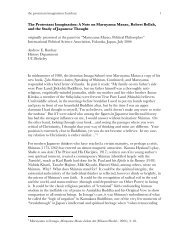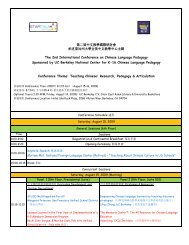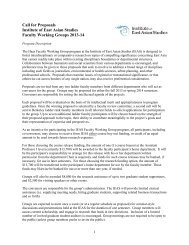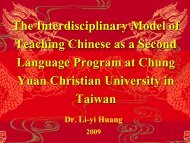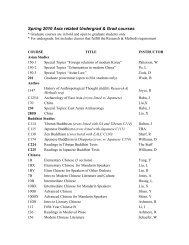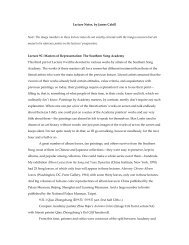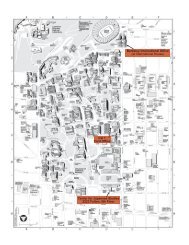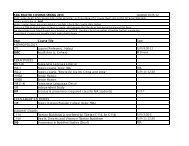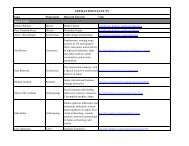Third Edition Spring 2013 - Institute of East Asian Studies, UC ...
Third Edition Spring 2013 - Institute of East Asian Studies, UC ...
Third Edition Spring 2013 - Institute of East Asian Studies, UC ...
Create successful ePaper yourself
Turn your PDF publications into a flip-book with our unique Google optimized e-Paper software.
Newar Buddhism in KathmanduWedged between India and Tibet, the Kathmandu Valley ishome to a form <strong>of</strong> Buddhism closely resembling late Indian Buddhismbefore its disappearance. Mixed with elements <strong>of</strong> Hinduismand the caste system, Newar Buddhism has several contrasting elementswith the Theravada tradition. The primary one being that“The monks are not celibate, renunciatory monks who out <strong>of</strong> vocationhave abandoned their families. Rather they are hereditarymarried monks who live outside the monastery, have pr<strong>of</strong>essions,and live within society.” 9 In other words, the Newar monks would,according to Theravada definitions, not be considered monks at all,despite having undergone similar ordination rituals and occupyinga similar place in Newar society. From a Theravada perspective,these are not monks but householders who have given up anascetic life. From the Newar perspective, however, they are seen as“householder monks.”The tradition <strong>of</strong> householder monks is not a recent developmentin Kathmandu; “The institution <strong>of</strong> householder monks wasprobably already well established…by the 11th century.” 10 Yet itwas not the only local tradition, as “at that time there was a coexistingtradition <strong>of</strong> celibate monasticism.” Indeed, a system <strong>of</strong> celibatemonkhood coexisted with the married monkhood in Kathmandu.Thus, this type <strong>of</strong> householder monk (whom Theravadans wouldnot consider a monk) has existed for almost a thousand years, attimes in concert with the celibate monkhood. It cannot be seen asa recent development in response to some sort <strong>of</strong> doctrinal challenge.By what means does a Newar become a householder monk?The ordination requirements are quite different from those <strong>of</strong> theTheravada traditions. Newar ordination is only open to youngprepubescent boys who are the sons <strong>of</strong> other monks. These adultmonks are in turn members <strong>of</strong> one specific caste the Śākya or Va-9 Von Rospatt p. 28210 Von Rospatt p. 294jrāchārya. The boys are welcomed into the fold <strong>of</strong> monkhood overa four-day period, beginning with an ordination rite. At the end<strong>of</strong> the ordination rite, the boys become fully ordained and truemonks. Over the next three days, the new monks participate in awide variety <strong>of</strong> rituals. At the end <strong>of</strong> the fourth day, the boys disrobeand return to their normal existence. However, for the rest <strong>of</strong>their lives, they are able to act and are treated as if they are fullfledgedmembers <strong>of</strong> a Buddhist sangha. The vast majority <strong>of</strong> theboys will never become household priests and be initiated into thesecret esoteric traditions <strong>of</strong> true clerics. Indeed, most grow up, getmarried, have children, and retain their day jobs. However, duringany period <strong>of</strong> ritual worship that requires them to act in their rolesas monks, they are able to do so and are treated as if they had neverrenounced their vows. “Thus, Newar Buddhism is not a ‘Buddhismwithout monks’ as some observers have held, but a Buddhism withmonks who have turned householders without giving up theiridentity as monastics.” 11 This identity is on full display during theNewar worship <strong>of</strong> the Primordial Buddha (Dīpaṃkara). The monks<strong>of</strong> the Newar sangha act as “merit fields” for people, receiving donationsjust as a renunciatory monk with an alms bowl would.While these householder monks are most certainly “Buddhist”in a Newar context and participate in ritual festivals, theydo so with some reluctance. During several <strong>of</strong> the major festivalswhere they are required to act in their role as a fields <strong>of</strong> merit forpeoples’ donations, on occasion they will not appear in person butrather send their children to receive donations, citing feelings <strong>of</strong>discomfort with receiving gifts from members <strong>of</strong> lower castes. Thereluctance to fulfill their monastic roles also makes them a poorchoice for tending to the ritual needs <strong>of</strong> the laity. Therefore, it isimportant to reiterate that the majority <strong>of</strong> (sometimes reluctant)householder monks do not perform the services typical <strong>of</strong> actualpriests. The reasons for this are tw<strong>of</strong>old. First, only those <strong>of</strong> the Vajrāchāryasubcaste are able to act as priests. Second, only a handful<strong>of</strong> those in the Vajrāchārya subcaste actually go on to take thenecessary additional esoteric ordination rites that allow them toperform as priests. This role is usually hereditary since the roles <strong>of</strong>11 Von Rospatt p. 29291 Robert Bowers Curl Laicization in Japanese Buddhism 92




